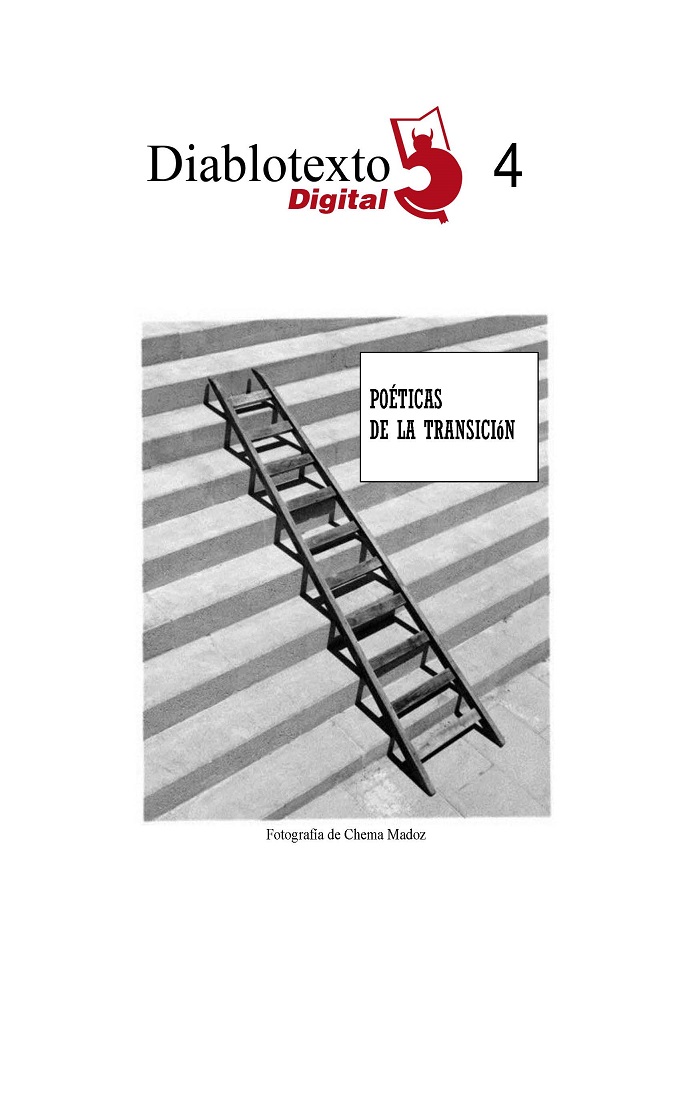La poesía es infinita: the metaliterary thoughts in Museo de cera, written by José María Álvarez
DOI:
https://doi.org/10.7203/diablotexto.4.13558Keywords:
metapoetry, 68th generation, Museo de cera, José María Álvarez Abstract
Abstract
The metapoetic concern has played an important role in the Spanish poetry from the middle of the 20th century onwards. Against the realism defended by the authors in the 40’s and 50’s, José María Álvarez revealed the need to attend the artistic fact. His greatest work, Museo de Cera, is a clear reflection of his literary ideas.
In this paper I will analise his conception of the poetic fact. In order to do this, I will study, on the one hand, extraliterary poetics and metapoetry. On the other hand, I will deal with how the meaning of the literary is configured in an indirect way, either through the study of explicit references or through the study of an existential concern.
 Downloads
Downloads
 References
References
Álvarez, José María (1971). 87 poemas. Madrid: Helios, colección saco roto.
Álvarez, José María (2001). Al otro lado del espejo / Diario de la Serpiente de Bronce. Murcia: Universidad de Murcia / Editora Regional de Murcia.
Álvarez, José María (2002). Museo de cera. Sevilla: Renacimiento.
Álvarez, José María (2006). Sobre la delicadeza de gusto y pasión. Sevilla: Renacimiento.
Álvarez, José María [2004] (2018). Los decorados del olvido. Sevilla: Renacimiento.
Bagué Quílez, Luis; Rodríguez Rosique, Susana (2013). “La ironía en segundo grado: (in)versiones discursivas en la poesía española reciente”, Bulletin of Hispanic Studies, vol. 3, n.º 90, pp. 295-310.
Bousoño, Carlos [1979] (1985). “La poesía de Guillermo Carnero”. En Poesía poscontemporánea. Cuatro estudios y una introducción. Madrid / Gijón: Júcar, pp. 227-301.
Castellet, José María [1970] (2018). Nueve novísimos poetas españoles. Barcelona: Península.
Cortázar, Julio [1959] (1982). Las armas secretas. Madrid: Alfaguara.
Díaz de Castro, Francisco (2006). Vidas pensadas. Poetas en el fin de siglo. Sevilla: Renacimiento, colección Iluminaciones.
Díez de Revenga, Francisco Javier; De Paco, Mariano (1989). Historia de la literatura murciana. Murcia: Editora Regional de Murcia.
García Martín, José Luis (2002). “Museo de cera, José María Álvarez”, en https://m.elcultural.com/revista/letras/Museo-de-cera/5130 [Fecha de consulta: 10 de octubre de 2018].
Genette, Gérard [1962] (1989). Palimpsestos. La literatura en segundo grado. Traducción de Celia Fernández Prieto. Madrid: Taurus.
Iravedra, Araceli (2016). Hacia la democracia. La nueva poesía (1968-2000). Madrid: Visor.
Martín Estudillo, Luis (2003). “Hacia una teoría de la metapoesía”, Revista de estudios hispánicos, vol. 30, n.º 2, pp. 141-152.
Pérez Parejo, Ramón (1996). Metapoesía y ficción: claves de una renovación poética. Madrid: Visor.
Prieto de Paula, Ángel Luis (1996). Musa del 68. Claves de una generación poética. Madrid: Hiperión.
Sánchez Dragó, Fernando (2003). “Negro sobre blanco. Episodio monográfico sobre y con el poeta José María Álvarez”, en http://elbotindelmundo.blogspot.com/2010/04/el-ultimo-dandy-de-nuestra-literatura.html [Fecha de consulta: 10 de octubre de 2018].
Siles, Jaime (1989). “Los novísimos: la tradición como ruptura, la ruptura como tradición”, Ínsula, n.º 595, pp. 9-11.
Downloads
Published
How to Cite
-
Abstract449
-
PDF (Español)281
Issue
Section
License
Licencia de reconocimiento de Creative Commons “Reconocimiento - No Comercia l- Sin Obra Derivada
Authors who publish with this journal agree to the following items:
The authors will keep their copyright and guarantee the journal the right of first publication of their work, which will be simultaneously subject to the Creative Commons license that allows third parties to share the work indicating its author and its first publication in the journal. The authors may adopt other non-exclusive license agreements to distribute the version of the published work (e.g., depositing it in an institutional telematic file or publishing it in a monographic volume), with an acknowledgment of its initial publication in this journal. The authors are allowed and encouraged to disseminate their work through the Internet (e.g., in institutional telematic archives or on their website) before and during the submission process, which can produce interesting exchanges and increase citations of the published work. (See Effect of Open Access)




